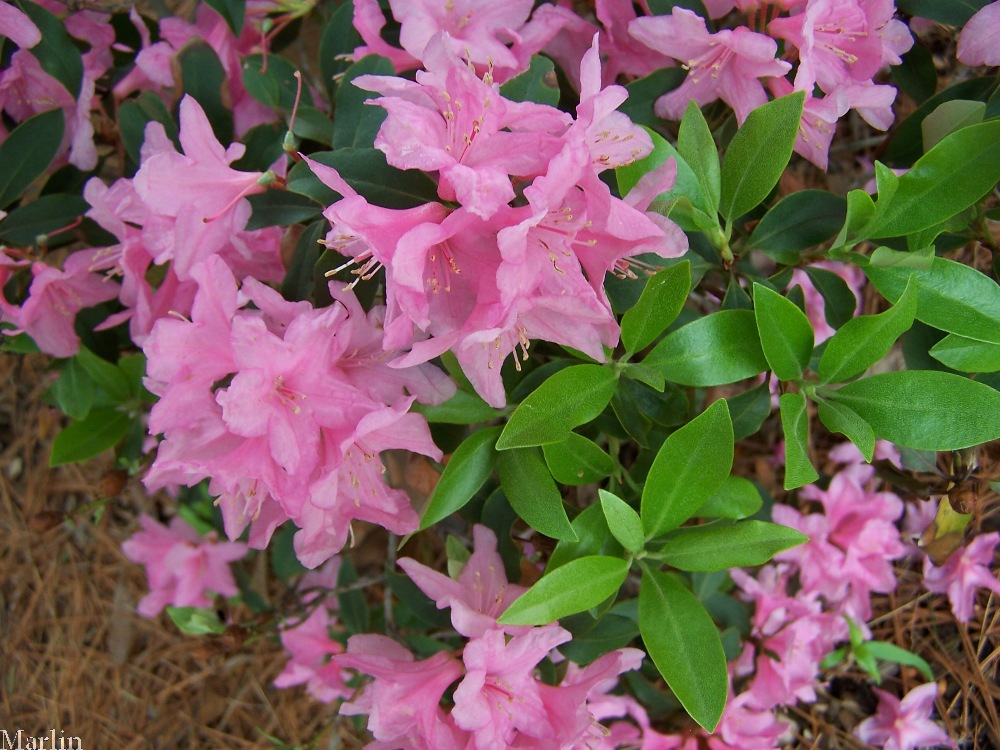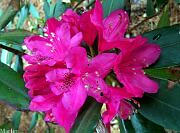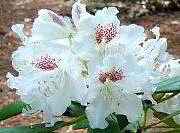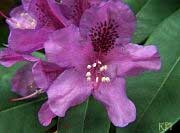| Weston's Mayflower Rhododendron Flowers | Index | Garden Slugs | Tree Encyclopedia | Rhododendrons | Rose Family Live specimens photographed at The Morton Arboretum, Lisle, Illinois, USA |
|

|
Rhododendron (from the Greek: rhodos, "rose", and dendron, "tree") is a genus of flowering plants in the Heath Family (Ericaceae). It is a large genus with over 1000 species. Most have very colorful, showy flowers. It includes the plants known to gardeners as azaleas.
Rhododendron grow as shrubs or small trees. The smallest species grows to 10-100 cm tall, and the largest, R. giganteum, has been reported at 90 feet. Leaves are spirally arranged; leaf size can range from 1-2 cm to over 50 cm, exceptionally 100 cm in R. sinogrande. They may be either evergreen or deciduous. In some species the underside of the leaves is covered with scales (lepidote) or hairs (indumentum. Some of the best known species are noted for their many clusters of large flowers. The Mezitt family, of Weston Nurseries at Hopkinton, Massachusetts, is responsible for a number of hardy rhododendron varieties. They have been breeding the plants for three generations, beginning in 1939. Some famous hybrids developed at the Weston Nursery include 'Blue Baron', the 'Mayflower' pictured here, 'Checkmate', 'Midnight Ruby', 'Red Quest', 'Cornell Pink', 'April Snow', 'April Cloud', 'Summer Peppermint', 'Tapestry', and 'Starry Night'. [2] |
 A 1971 cross by Ed Mezitt produced Weston's Mayflower |
|
Both species and hybrid rhododendrons (including azaleas) are used extensively as ornamental plants in landscaping in many parts of the world, and many species and cultivars are grown commercially. Most large commercial growers in the United States are located on the west coast.
Rhododendrons are valued in landscaping for their structure, size, flowers, and the fact that many of them are evergreen. Azaleas are frequently used around foundations and occasionally as hedges, and many larger-leafed rhododendrons lend themselves well to more informal plantings and woodland gardens, or as specimen plants. In some areas, larger rhododendrons can be pruned to encourage more tree-like form, with some such as R. arboreum and R. falconeri eventually growing to 10-15 m or more tall. Most rhododendrons prefer acid soils with a pH of roughly 4.5-5.5; some tropical Vireyas and a few other rhododendron species grow as epiphytes and need a planting mix similar to that required for orchids. Rhododendrons have fibrous roots and prefer well-drained soils high in organic material. In areas with poorly-drained or alkaline soils, rhododendrons are often grown in raised beds using mediums such as composted pine bark. Mulching and careful watering are important, especially before the plant is established. There are a number of insects that either target rhododendrons or will opportunistically attack them. Rhododendron borers and various weevils are major pests of rhododendrons, and many caterpillars will attack rhododendrons. Major diseases include Phytophthora root rot, stem and twig fungal dieback. [2] All parts of Rhododendrons are toxic to animals if ingested. Symptoms include vomiting, diarrhea, hyper-salivation, weakness, coma, hypotension, CNS depression, cardiovascular collapse and death. [4] (Yikes) |
 Nova Zembla Rhododendron |
 Peter Tigerstedt Rhododendron |
 Weston's Tapestry Rhododendron |
References:
|
 |
Common North American Flowers A flower is the reproductive structure found in flowering plants (plants of the division Magnoliophyta, also called angiosperms). The flower contains the plant's reproductive organs, and its function is to produce seeds. After fertilization, portions of the flower develop into a fruit containing the seeds. Tree Encyclopedia | Trees Index | Rhododendrons | Fruit Trees |
